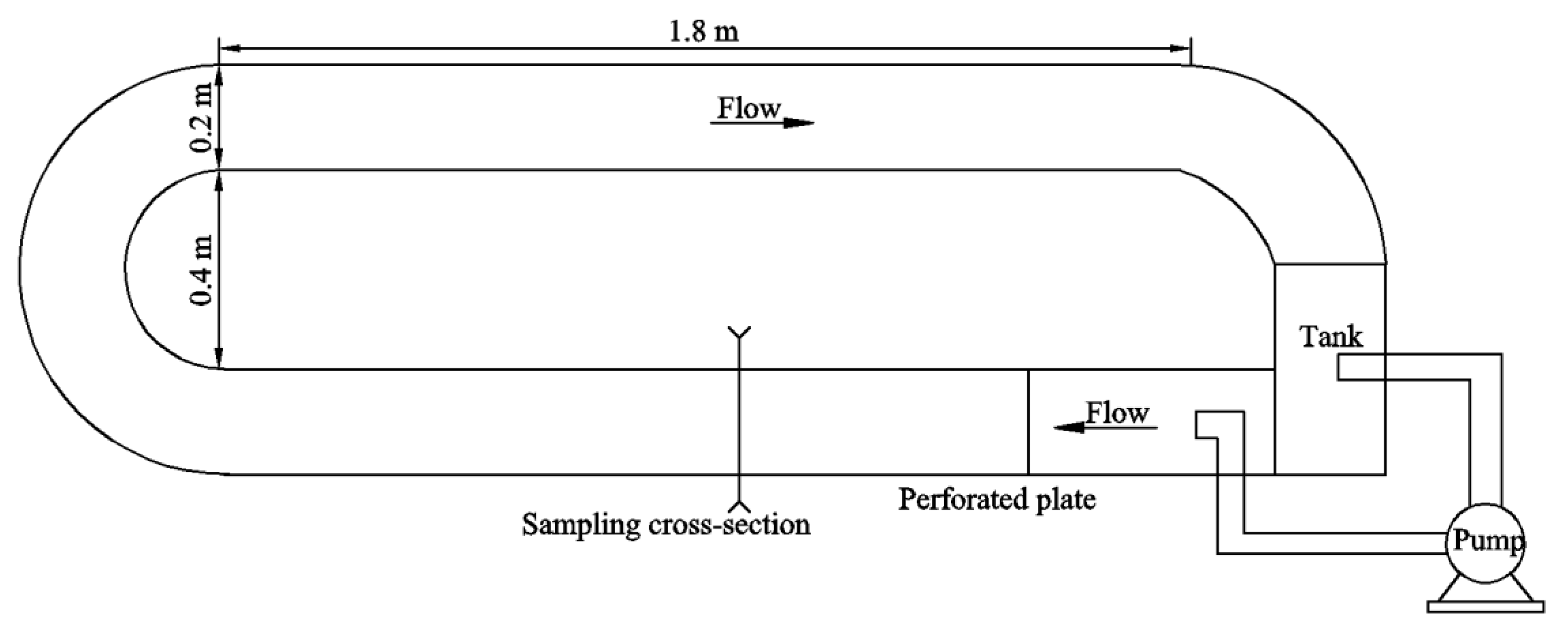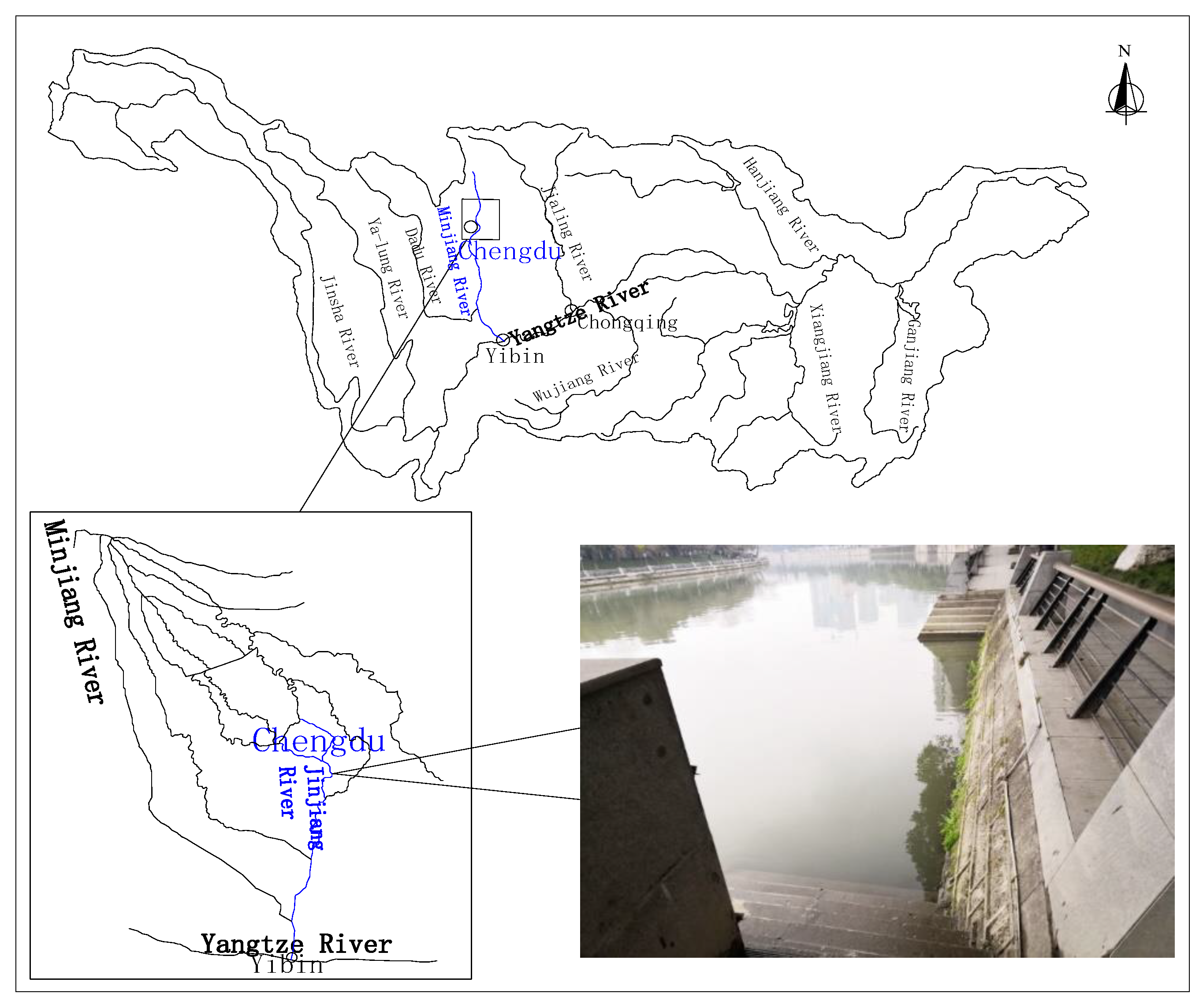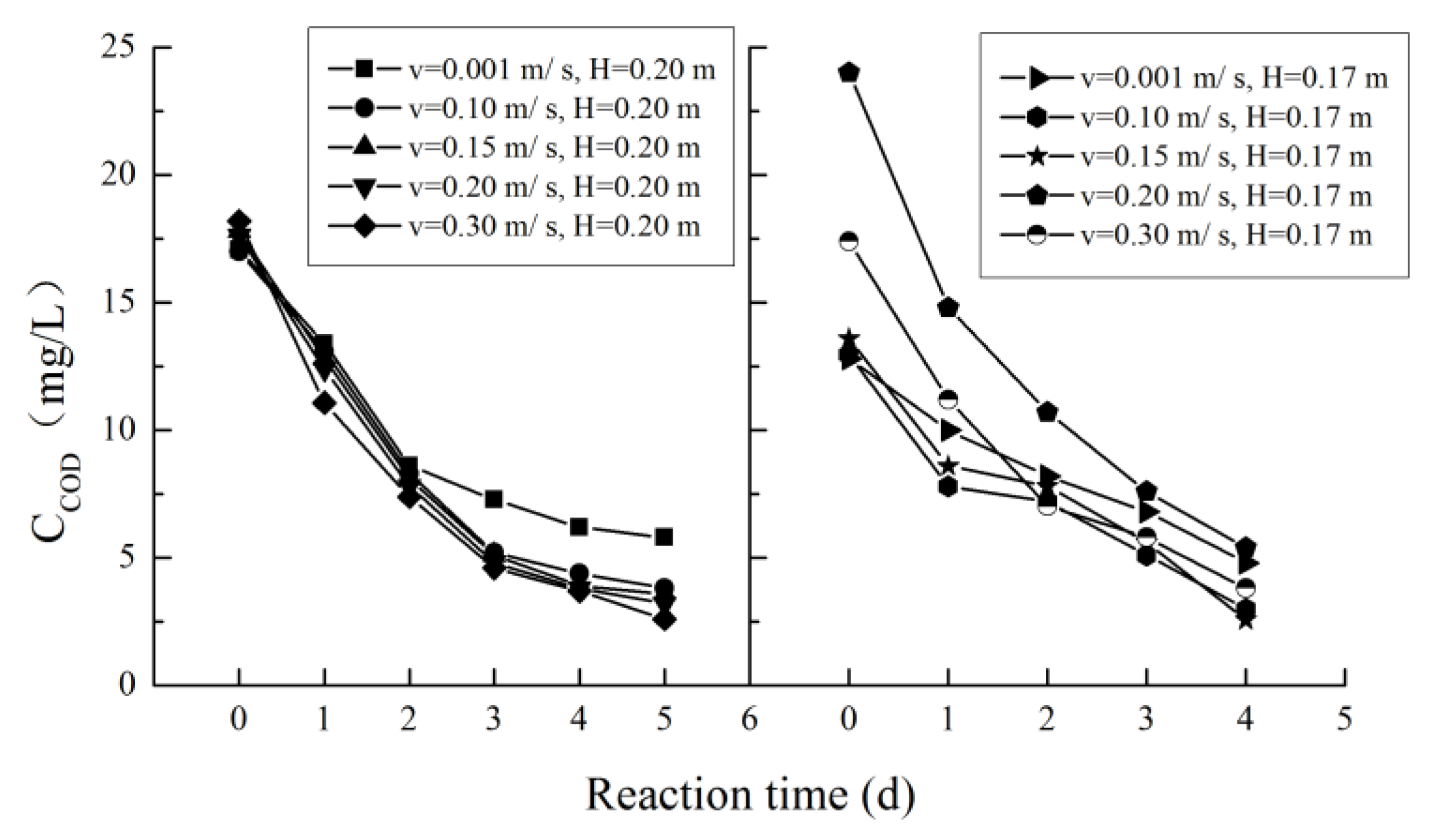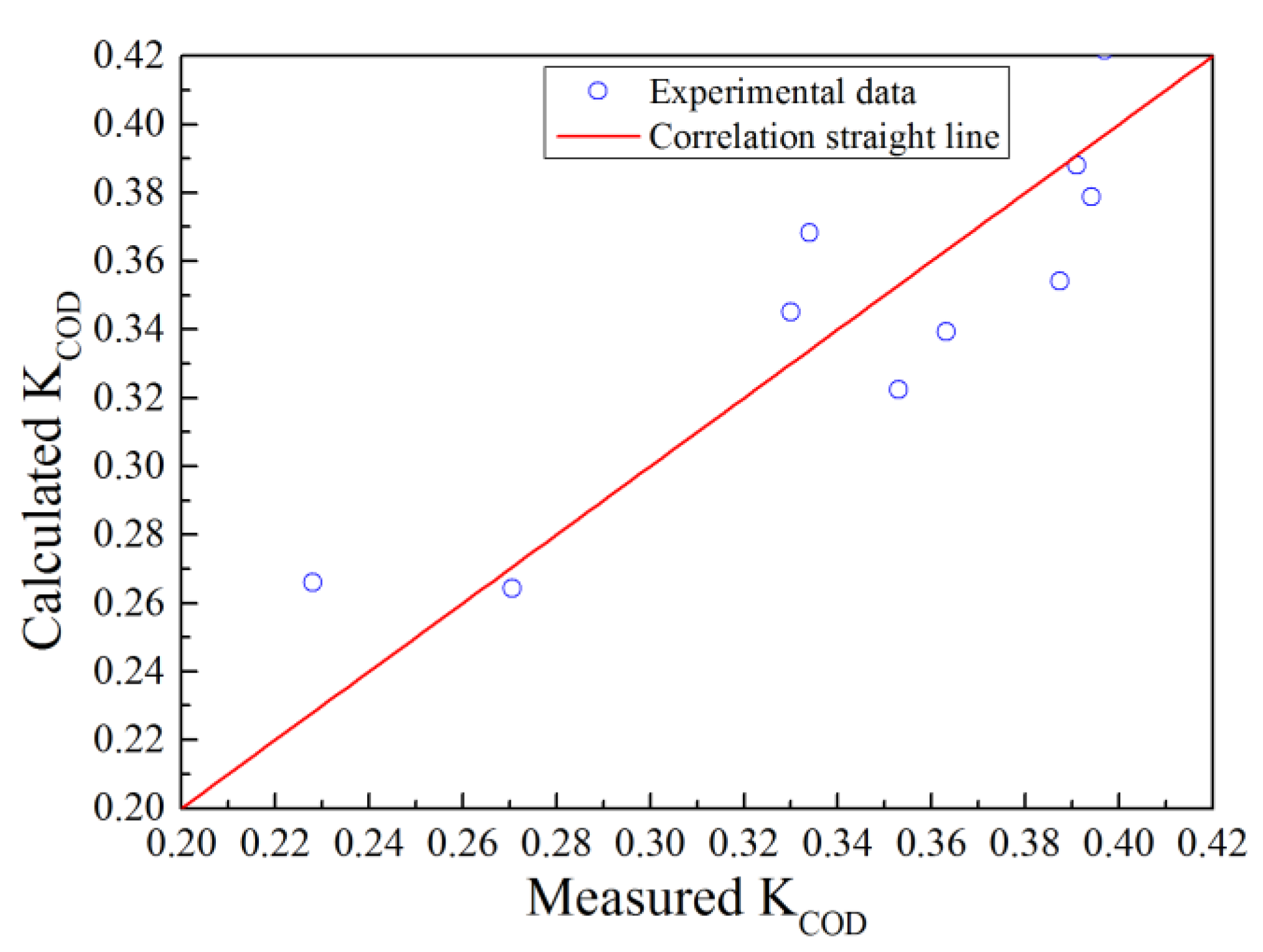Experimental Investigation on the Relationship Between COD Degradation and Hydrodynamic Conditions in Urban Rivers
Abstract
:1. Introduction
2. Materials and Methods
2.1. Experimental Device
2.2. Experimental Methods and Materials
2.3. Methods for Monitoring and Measurement
2.4. Setup of Scenarios
3. Results
3.1. The COD Degradation Process and Degradation Coefficient
3.2. Analysis of the Relationship Between the Degradation Coefficient and Hydraulic Conditions
3.3. Verification of the Formula Using Field Observation Data
4. Discussion
4.1. Influence of the DO Concentration
4.2. The Effect of Biochemical Process
4.3. Different Source of Water
4.4. Content of Sediment
4.5. Uncertainty of the Results
5. Conclusions and Prospects
Author Contributions
Funding
Conflicts of Interest
References
- Angela, G.; May, L.; Catherine, S. Urban Rivers: Hydrology, Geomorphology, Ecology and Opportunities for Change. Geogr. Compass 2007, 1, 1118–1137. [Google Scholar]
- Chen, W.Y. Environmental Externalities of Urban River Pollution and Restoration: A Hedonic Analysis in Guangzhou (China). Landsc. Urban Plan. 2017, 157, 170–179. [Google Scholar] [CrossRef]
- Peng, Y.; Fang, W.; Krauss, M.; Wang, Z.; Lia, F.; Zhang, X. Screening hundreds of emerging organic pollutants (EOPs) in surface water from the Yangtze River Delta (YRD): Occurrence, distribution, ecological risk. Environ. Pollut. 2018, 241, 484–493. [Google Scholar] [CrossRef] [PubMed]
- Aoki, S.; Fuse, Y.; Yamada, E. Determinations of Humic Substances and Other Dissolved Organic Matter and Their Effects on the Increase of Cod in Lake Biwa. Anal. Sci. 2004, 20, 159–164. [Google Scholar] [CrossRef] [PubMed]
- Knapik, H.G. Organic Matter Characterization and Modeling in Polluted Rivers for Water Quality Planning and Management. J. Asian Stud. 2014, 20, 10. [Google Scholar]
- Vagnetti, R.; Miana, P.; Fabris, M.; Pavoni, B. Self-purification ability of a resurgence stream. Chemosphere 2003, 52, 95–1781. [Google Scholar] [CrossRef]
- Reardon, K.F.; Mosteller, D.C.; Bull Rogers, J.D. Biodegradation Kinetics of Benzene, Toluene, and Phenol as Single and Mixed Substrates for Pseudomonas Putida F1. Biotechnol. Bioeng. 2000, 69, 385–400. [Google Scholar] [CrossRef]
- Wright, R.M.; Mcdonnell, A.J. In-stream Deoxygenation Rate Prediction. J. Environ. Eng. Div. 1979, 105, 323–335. [Google Scholar]
- Dunalska, J.A.; Górniak, D.; Jaworska, B.; Gaiser, E.E. Effect of Temperature on Organic Matter Transformation in a Different Ambient Nutrient Availability. Ecol. Eng. 2012, 49, 27–34. [Google Scholar] [CrossRef]
- Skadsen, J. Effectiveness of High Ph in Controlling Nitrification. J. Am. Water Work. Assoc. 2002, 94, 73–83. [Google Scholar] [CrossRef]
- Watanabe, K. Microorganisms Relevant to Bioremediation. Curr. Opin. Biotechnol. 2001, 12, 237–241. [Google Scholar] [CrossRef]
- Saito, M.; Magara, Y. Study on Self-purification Capacity for Organic Pollutants in Stagnant Water. Water Sci. Technol. 2002, 46, 137. [Google Scholar] [CrossRef]
- Leblanc, L.A.; Gulnick, J.D.; Brownawell, B.J.; Taylor, G.T. The Influence of Sediment Resuspension on the Degradation of Phenanthrene in Flow-through Microcosms. Mar. Environ. Res. 2006, 61, 202–223. [Google Scholar] [CrossRef]
- Huang, B.; Hong, C.; Du, H.; Qiu, J.; Liang, X.; Tan, C.; Liu, D. Quantitative Study of Degradation Coefficient of Pollutant Against the Flow Velocity. J. Hydrodyn. 2017, 29, 118–123. [Google Scholar] [CrossRef]
- Shu, S.; Ma, H. Comparison of two models for calculating water environment capacity of Songhua River. In Life System Modeling and Intelligent Computing; Springer: Berlin/Heidelberg, Germany, 2010; pp. 683–690. [Google Scholar]
- Pu, X.; Li, K.; Li, J.; Zhao, W. The effect of turbulence in water body on organic compound biodegradation. China Environ. Sci. 1999, 19, 485–489. (In Chinese) [Google Scholar]
- Wang, P.; Wang, X.; Wang, C. Experiment of impact of river hydraulic characteristics on nutrients purification coefficient. J. Hydrodyn. 2007, 19, 387–393. [Google Scholar] [CrossRef]
- Yu, Y.; Wu, J.; Wang, X.; Zhang, Z.M. Degradation of Inorganic Nitrogen in Beiyun River of Beijing, China. Procedia Environ. Sci. 2012, 13, 1069–1075. [Google Scholar] [CrossRef] [Green Version]
- Metcalf; Eddy. Wastewater Engineering: Treatmentm Disposal, Reuse; McGraw-Hill: New York, NY, USA, 1979. [Google Scholar]
- Nielsen, P.-H.; Bjerg, P.-L.; Nielsen, P.; Smith, P.; Christensen, T.H. In situ and laboratory determined first-order degradation rate constants of specific organic compounds in anaerobic aquifer. Environ. Sci. Technol. 1995, 30, 31–37. [Google Scholar] [CrossRef]
- Theriault, E.J. The Rate of Deoxygenation of Polluted Waters. Public Health Rep. 1926, 41, 207–217. [Google Scholar] [CrossRef]
- Khanna, D.R.; Bhutiani, R.; Chandra, K.-S. A recursive approach for numerically identified DO-BOD interaction and kinetic formulation for water quality probability. Int. J. Environ. Waste Manag. 2012, 10, 391. [Google Scholar] [CrossRef]
- Manson, J.R.; Wallis, S.G. Rivers–Physical, Fluvial and Environmental Processes; Springer: Berlin/Heidelberg, Germany, 2015; pp. 543–566. [Google Scholar]
- Schiller, D.V.; Acuña, V.; Aristi, I.; Arroita, M.; Basaguren, A.; Bellin, A.; Boyero, L.; Butturini, A.; Ginebreda, A.; Kalogianni, E.; et al. River Ecosystem Processes: A Synthesis of Approaches, Criteria of Use and Sensitivity to Environmental Stressors. Sci. Total Environ. 2017, 596, 465–480. [Google Scholar] [CrossRef]
- Pan, W.; Xiong, Y.; Huang, Q.; Huang, G. Removal of Nitrogen and Cod from Reclaimed Water During Long-term Simulated Soil Aquifer Treatment System Under Different Hydraulic Conditions. Water 2017, 9, 786. [Google Scholar] [CrossRef]
- Wang, J.; Li, Y.; Wang, P.; Zhang, W.; Wang, C. Response of Bacterial Community Compositions to Different Sources of Pollutants in Sediments of a Tributary of Taihu Lake, China. Environ. Sci. Pollut. Res. 2016, 23, 13886–13894. [Google Scholar] [CrossRef]
- Lin, Y.; Li, D.; Zeng, S.; He, M. Changes of Microbial Composition During Wastewater Reclamation and Distribution Systems Revealed by High-throughput Sequencing Analyses. Front. Environ. Sci. Eng. 2016, 10, 539–547. [Google Scholar] [CrossRef]
- Harremoes, P.; Napstjert, L.; Rye, C.; Larsen, H.O.; Dahl, A. Impact of Rain Runoff on Oxygen in an Urban River. Water Sci. Technol. 1996, 34, 41–48. [Google Scholar] [CrossRef]
- Han, Y.; Zhai, S.; Sun, H. An Estimation Model of River COD Degradation Coefficient from River Velocity and COD Density. Environ. Monit. China 1998, 14, 40–42. (In Chinese) [Google Scholar]
- Tang, G.; Zhu, Y.; Wu, G.; Li, J.; Li, Z.-L.; Sun, J. Modelling and Analysis of Hydrodynamics and Water Quality for Rivers in the Northern Cold Region of China. Int. J. Environ. Res. Public Health 2016, 13, 408. [Google Scholar] [CrossRef]
- Liu, X.; Jiang, J.; Yan, Y.; Dai, Y.; Deng, B.; Ding, S.; Su, S.; Sun, W.; Li, Z.; Gan, Z. Distribution and Risk Assessment of Metals in Water, Sediments, and Wild Fish from Jinjiang River in Chengdu, China. Chemosphere 2018, 196, 45. [Google Scholar] [CrossRef]
- Feng, Q.; Han, L.; Tan, X.; Zhang, Y.; Meng, T.; Lu, J.; Lv, J. Bacterial and Archaeal Diversities in Maotai Section of the Chishui River, China. Curr. Microbiol. 2016, 73, 924–929. [Google Scholar] [CrossRef]






| No. | Velocity (m/s) | Water Depth (m) | Sampling Date |
|---|---|---|---|
| Scenario 1 | 0.001 | 0.20 | 23-2-2019 |
| Scenario 2 | 0.10 | 0.20 | 23-2-2019 |
| Scenario 3 | 0.15 | 0.20 | 23-2-2019 |
| Scenario 4 | 0.20 | 0.20 | 23-2-2019 |
| Scenario 5 | 0.30 | 0.20 | 23-2-2019 |
| Scenario 6 | 0.001 | 0.17 | 10-7-2019 |
| Scenario 7 | 0.10 | 0.17 | 16-7-2018 |
| Scenario 8 | 0.15 | 0.17 | 26-7-2018 |
| Scenario 9 | 0.20 | 0.17 | 9-9-2018 |
| Scenario 10 | 0.30 | 0.17 | 1-7-2018 |
| No. | Velocity (m/s) | Initial CCOD (mg/L) | Water Temperature (°C) | Fitted KCOD before Temperature Correction (1/d) | Temperature Correction Coefficient | Corrected KCOD (1/d) |
|---|---|---|---|---|---|---|
| Scenario 1 | 0.001 | 17.08 | 19.0 | 0.258 | 1.047 | 0.271 |
| Scenario 2 | 0.10 | 17.00 | 19.5 | 0.345 | 1.023 | 0.353 |
| Scenario 3 | 0.15 | 17.80 | 20.8 | 0.377 | 0.964 | 0.363 |
| Scenario 4 | 0.20 | 17.60 | 20.2 | 0.391 | 0.991 | 0.387 |
| Scenario 5 | 0.30 | 18.20 | 22.0 | 0.432 | 0.912 | 0.394 |
| Scenario 6 | 0.001 | 12.80 | 20.0 | 0.228 | 1.000 | 0.228 |
| Scenario 7 | 0.10 | 12.96 | 20.0 | 0.330 | 1.000 | 0.330 |
| Scenario 8 | 0.15 | 13.60 | 20.0 | 0.334 | 1.000 | 0.334 |
| Scenario 9 | 0.20 | 24.00 | 20.0 | 0.391 | 1.000 | 0.391 |
| Scenario 10 | 0.30 | 17.40 | 20.0 | 0.397 | 1.000 | 0.397 |
| No. | Initial (mg/L) | u/h (1/s) | Fr | Re | (1/d) |
|---|---|---|---|---|---|
| Scenario 1 | 17.08 | 0.005 | 0.001 | 66 | 0.271 |
| Scenario 2 | 17.00 | 0.500 | 0.071 | 6622 | 0.353 |
| Scenario 3 | 17.80 | 0.750 | 0.107 | 9933 | 0.363 |
| Scenario 4 | 17.60 | 1.000 | 0.143 | 13245 | 0.387 |
| Scenario 5 | 18.20 | 1.500 | 0.214 | 19867 | 0.394 |
| Scenario 6 | 12.80 | 0.006 | 0.001 | 63 | 0.228 |
| Scenario 7 | 12.96 | 0.588 | 0.077 | 6254 | 0.330 |
| Scenario 8 | 13.60 | 0.882 | 0.116 | 9382 | 0.334 |
| Scenario 9 | 24.00 | 1.176 | 0.155 | 12509 | 0.391 |
| Scenario 10 | 17.40 | 1.765 | 0.232 | 18763 | 0.397 |
| Date | Length of River Reach (km) | Velocity (m/s) | Water Depth (m) | Width (m) | Water Temperature (°C) | CCOD at the Maotai Section (mg/L) | CCOD at the Lianghekou Section (mg/L) |
|---|---|---|---|---|---|---|---|
| 3-1-2017 | 43.4 | 0.61 | 0.78 | 81.6 | 11.4 | 17.3 | 15 |
| 6-4-2017 | 43.4 | 0.89 | 1.41 | 82.8 | 19.8 | 16.3 | 14 |
| 3-7-2017 | 43.4 | 1.17 | 2.16 | 84.3 | 28.0 | 18.3 | 15 |
| Date | Calculated KCOD (1/d) | Measured KCOD (1/d) | Error |
|---|---|---|---|
| 3-1-2017 | 0.175 | 0.234 | 25.3% |
| 6-4-2017 | 0.256 | 0.271 | 5.4% |
| 3-7-2017 | 0.373 | 0.463 | 19.5% |
© 2019 by the authors. Licensee MDPI, Basel, Switzerland. This article is an open access article distributed under the terms and conditions of the Creative Commons Attribution (CC BY) license (http://creativecommons.org/licenses/by/4.0/).
Share and Cite
Tang, L.; Pan, X.; Feng, J.; Pu, X.; Liang, R.; Li, R.; Li, K. Experimental Investigation on the Relationship Between COD Degradation and Hydrodynamic Conditions in Urban Rivers. Int. J. Environ. Res. Public Health 2019, 16, 3447. https://doi.org/10.3390/ijerph16183447
Tang L, Pan X, Feng J, Pu X, Liang R, Li R, Li K. Experimental Investigation on the Relationship Between COD Degradation and Hydrodynamic Conditions in Urban Rivers. International Journal of Environmental Research and Public Health. 2019; 16(18):3447. https://doi.org/10.3390/ijerph16183447
Chicago/Turabian StyleTang, Lei, Xiangdong Pan, Jingjie Feng, Xunchi Pu, Ruifeng Liang, Ran Li, and Kefeng Li. 2019. "Experimental Investigation on the Relationship Between COD Degradation and Hydrodynamic Conditions in Urban Rivers" International Journal of Environmental Research and Public Health 16, no. 18: 3447. https://doi.org/10.3390/ijerph16183447




